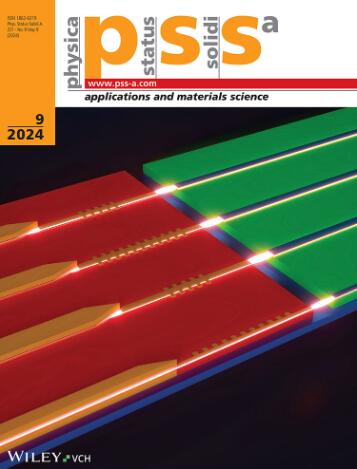增强掺锡氧化钴纳米片表面积对超级电容器应用的影响
IF 1.9
4区 材料科学
Q3 MATERIALS SCIENCE, MULTIDISCIPLINARY
Physica Status Solidi A-applications and Materials Science
Pub Date : 2024-08-30
DOI:10.1002/pssa.202400502
引用次数: 0
摘要
采用简单、经济的共沉淀法合成了纯 Co3O4 和 5% 掺杂 Sn 的 Co3O4 纳米片。分别利用 X 射线衍射数据(XRD)、傅立叶变换红外光谱(FT-IR)、拉曼分析、紫外-可见光、场发射扫描显微镜、能量色散 X 射线分析和布鲁纳-埃美特-泰勒(BET)分析了晶体学参数、化学成分、形态特性、光学特性和表面积。通过在 2 m KOH 电解液中使用循环伏安法和电化学阻抗光谱法,验证了纯 Co3O4 和 5% 掺杂 Sn Co3O4 的电化学特性。样品结果表明,Sn2+ 的存在对 Co3O4 的表面积、带隙、比电容和电化学性能都有影响。根据 XRD 数据,合成材料具有立方结构。利用 BET 对样品的表面积进行了仔细研究,结果显示其表面积为 1084.998 m2 g-1,高于纯 Co3O4(92.842 m2 g-1),这表明随着掺杂浓度的增加,表面积也在增加。据观察,掺杂 5%锡的多孔 Co3O4 纳米薄片具有较高的比电容,即 203.6 F g-1,同时具有较高的表面积。我们还注意到,掺杂 5% 锡的比电容发生了急剧变化。这些观察和实验结果表明,所设计的电极是超级电容器应用的理想候选材料。本文章由计算机程序翻译,如有差异,请以英文原文为准。
Effect of Enhancement in Surface Area of Sn‐Doped Cobalt Oxide Nanoflakes for Supercapacitor Application
The simple and cost‐effective co‐precipitation method is used for the synthesis of pure Co3 O4 and 5% Sn‐doped Co3 O4 nanoflakes. Crystallographic parameters, chemical composition, morphological properties, optical properties, and surface area are analyzed using X‐ray diffraction data (XRD), Fourier transform infrared spectroscopy (FT‐IR), Raman analysis, UV–vis, field emission scanning microscopy, energy‐dispersive X‐ray analysis, and Brunauer–Emmett–Teller (BET), respectively. By using cyclic voltammetry and electrochemical impedance spectroscopy in a 2 m KOH electrolyte, the electrochemical characteristics of both pure and 5% Sn‐doped Co3 O4 are verified. The sample results show that the presence of Sn2+ has an impact on surface area, band gap, specific capacitance, and electrochemical performance of Co3 O4 . According to XRD data, synthetic material has a cubic structure. The surface area of the sample is scrutinized using BET which exhibits a higher surface area of 1084.998 m2 g−1 than pure Co3 O4 (92.842 m2 g−1 ) demonstrating that enhancement in surface area as dopant concentration increases. It is observed that porous 5% Sn‐doped Co3 O4 nanoflakes has the higher specific capacitance, i.e., 203.6 F g−1 with a high surface area. It is well noticed that drastic change in specific capacitance with 5% Sn doping. These observations and experiments reveal that designed electrode is a promising candidate for supercapacitor application.
求助全文
通过发布文献求助,成功后即可免费获取论文全文。
去求助
来源期刊
CiteScore
3.70
自引率
5.00%
发文量
393
审稿时长
2 months
期刊介绍:
The physica status solidi (pss) journal group is devoted to the thorough peer review and the rapid publication of new and important results in all fields of solid state and materials physics, from basic science to applications and devices. Among the largest and most established international publications, the pss journals publish reviews, letters and original articles, as regular content as well as in special issues and topical sections.

 求助内容:
求助内容: 应助结果提醒方式:
应助结果提醒方式:


